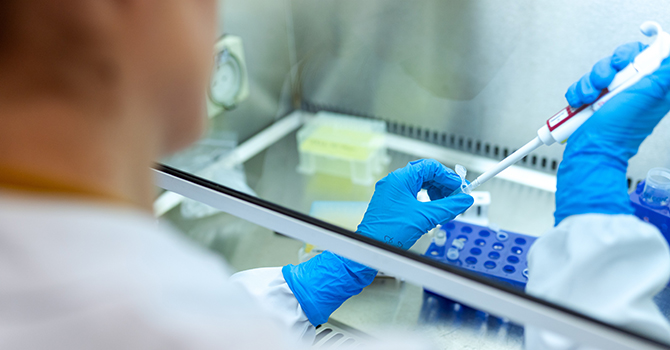Coronavirus: The Long Path to a Vaccine

Q&A with Emily Martin
Associate Professor of Epidemiology
The essential question surrounding coronavirus is, how do we stop it? Right now, there is still no known medication to prevent or treat it. The only therapy that exists focuses on alleviating the symptoms, like fever and cough. Theories about drugs that will supposedly help treat coronavirus have floated around the media. So-called treatments are being debunked, lauded, and may even be putting people at risk. As the public holds out hope for a quick treatment, people are asking—when are we going to have a vaccine for this disease?
Emily Martin is an associate professor of epidemiology at the University of Michigan School of Public Health, and an expert in viral respiratory illnesses. She explains what it takes to create a vaccine, and how long it will take to make a coronavirus vaccine available to the public.
The virus was discovered in Wuhan, China in December 2019, and it has been in the US for over a month. What is the timeline to make a vaccine available?
Vaccines take so long to make because there are several time-consuming steps. First you have to devise a vaccine in the lab. Then you have rounds of testing on animals and then on people. We are looking both for safety and for durability, or effectiveness, of the vaccine -what we call the “efficacy” of the vaccine in a trial. Essentially what we're looking for is this: if you give the vaccine to someone, are they protected for the necessary period of time to get them through the epidemic?
The problem is, we can't fast-forward test results. We have to examine the vaccine's efficacy over the same duration of time as we would need someone to be protected from the virus. When we want a vaccine to protect people for a couple of months at a minimum, it means that we need to wait until we've been able to test people and follow them for that same amount of time. That’s what inevitably causes a delay in a vaccine being ready.
If an effective vaccine is found, there's still 12 to 18 months of testing between its development and its entry into use because we don't use vaccines unless they are proven to be safe. We do not use vaccines that will not have a benefit.
Something that would fundamentally change the shape of the epidemic now would be the development of anti-virals and other treatments. If an effective treatment is found now, that treatment can likely be deployed instantly and will save lives.
People have likened this virus to the seasonal flu. Is that an accurate comparison? And does this mean that the current flu vaccine can be used to help us fight coronavirus?
Coronaviruses and flu viruses are both RNA viruses—a virus that has RNA as its genetic material. But they are a little bit like apples and oranges in terms of the way the viruses are structured. They evolve differently and they use cells in different ways to cause infection. So unfortunately, there's not a lot that we can take from influenza itself to inform what we know about coronavirus.
However, all of the challenges that we have had developing the influenza vaccine means that there's already been an incredible investment in new and rapid vaccine development technology. Some of those technologies are being deployed to make constructs that could potentially become coronavirus vaccines. Because we've invested so much in trying to develop universal influenza vaccines, we now have better technology and better science that will hopefully make the search for coronavirus vaccines fare better.
As we’ve been able to study the virus more, we’ve learned more about its origins. We now know that coronavirus began in animals and "spilled over," infecting humans. Should we be concerned about these "spillover" incidents continuing to happen to create more viruses?
There are actually interesting studies of people that live near bat caves where they’ve found that those people have antibodies to all kinds of animal and bat viruses. That leads us to believe that there is what we would call “chatter” of exposure of animal viruses into humans that happens regularly. However, for those exposures to become even a small outbreak, it means it needs to cause an infection in one human to the degree where that human then spreads it to another human, and then that human then spreads to another human—that's what we would call sustained human-to-human transmission.
In the field of epidemiology, we are pretty accustomed to the idea that these types of "spillover" events, where viruses in animals spread to humans, actually happen all the time. There are many individual animal viruses that humans are exposed to where a single human might be intermittently infected by it but then they clear the infection. The infection is then stopped in its tracks and will not be transmitted from person to person.
Actually, the number of barriers that we have as humans to stop that from happening is pretty expansive. The human body is pretty good at shutting down the spillover transmission process so that's how the opportunity for this can happen so often between animals and humans yet that continued spread is very rarely seen.
- Learn more about Epidemiology at Michigan Public Health.
- Support research at Michigan Public Health.
